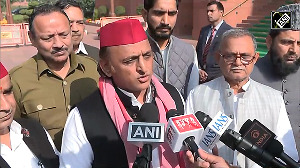 In this second part of the interview with Business Standard, Environment Minister Jairam Ramesh talks of his domestic agenda, and what he plans to do in terms of greening the power and transport sectors - from switching to new technologies in thermal power generation to outlining "go" and "no go" areas for coal mining, depending on the extent of forest cover in the coalfields; and from stipulating new emission standards for the auto industry to stressing technological change in the railways. Excerpts:
In this second part of the interview with Business Standard, Environment Minister Jairam Ramesh talks of his domestic agenda, and what he plans to do in terms of greening the power and transport sectors - from switching to new technologies in thermal power generation to outlining "go" and "no go" areas for coal mining, depending on the extent of forest cover in the coalfields; and from stipulating new emission standards for the auto industry to stressing technological change in the railways. Excerpts:
Can you elaborate on your domestic green agenda? What is it, how are you prioritising it, and is there a timeline?
The Planning Commission has announced the establishment of the expert group on a low-carbon economy. We have started serious thinking on how to achieve 20 to 25 per cent reduction in emission intensity by 2020, on the 2005 level.
Our preliminary work has suggested it is eminently feasible. Now we have to get into the nitty gritty - power, transport, buildings and agriculture.
What are you doing in the power sector?
Between 50 and 60 per cent of greenhouse gas emissions are accounted for by the power sector. One big constraint we have is that coal will remain the mainstay of the power economy. Broadly, the objective is that we want to add 13,000 MW every year, and 6,000-7,000 MW will come from coal alone.
That is assuming that our renewable energy programme picks up, the nuclear energy programme picks up, more gas will be used for power generation, and assuming that we are able to sort out many of the environmental problems associated with hydel. Under the best case scenario for non-coal, coal's contribution will still be 6,000-7,000 MW.
So what does that mean?
There are two problems. One is, we will be using largely domestic coal, because we have the world's third largest coal reserves and we are not going to be able to import much coal. Today 10 per cent of coal is imported. We don't want to be in a situation where 50 per cent of our coal is imported.
We are producing 500 million tonnes of coal, and will produce a billion tonne in 7 to 8 years' time. All incremental coal will come from our coal reserves in Jharkhand, Orissa and Chhattisgarh, and the reserves are in medium and good canopy forest areas. So we have a problem there on coal.
Secondly, we have a problem on CO2 emissions. The single-most important technology transition that has to take place in the power sector is to move from sub-critical to super-critical and ultra super-critical generation. This means increasing the temperatures at which steam gets generated and used.
How much does that change things?
It reduces greenhouse gas emissions by 10 per cent. India's first super-critical project will be commissioned by end of 2011. It is coming up at Mundra, a Tata Power project. Technology for the boilers is from Dusan in South Korea, and core technology for the turbines is from Toshiba. That will be the first. It is five units of 800MW each.
Does this raise the cost of electricity?
It is all competitively bid, tariff-based bidding. They have taken into account the associated costs of technology. And you use less coal. The capital cost is more, undoubtedly. But the world over, people are moving to this technology. We have started the transition.
What else are you doing to green the power sector?
A second transition will be in combined cycle coal gasification. India's first integrated gasification combined cycle (IGCC) unit is a 122 MW coal-based plant coming up in Vjayawada, and will take about three years to commission. Bhel and APGenco have a joint venture for that. The United States is working on a 600 MW IGCC plant, and so is China.
The two most important options in coal-based power generation are super-critical and ultra super-critical, and IGCC. If we are going to continue this extraordinarily high level of dependence on coal, we have to rethink our technology strategy as far as coal combustion is concerned.
What about the forestry angle to coal mining?
I have to admit, I wear two hats. One is to help in the build-up of power generating capacity, because I was in the power ministry also. Now I have to look at it from a different angle. I have to look at it from the forestry angle. I am faced with a serious situation in Chhattisgarh. Some of the best forest areas will be destroyed for the next 30 years. I hope they will be regenerated 30 years from now. But we have to take a 30year hiatus between destruction and regeneration.
One of the things we are doing is taking major coalfields and dividing them into goareas and no go-areas. We have mapped the North Karanpura coalfield, where we have identified 59 mines, of which 38 happen to be in the go areas.
These are in forest areas where tree density is low and we can work there. The remaining 21 are in no go areas. We have suggested to the ministry of coal, rethink your production strategy and maximise production in the go areas and keep out the no go areas for the time being, till we work out some alternative.
Any other coalfields where this is being done?
We are doing this for seven big coalfields of India. North Karanpura was the first. We are doing it for Talcher, and Ib Valley. The fact is the more coal we produce, the more forests we are going to give up. That will have its own impact on global warming. But India has not been a contributor to deforestation.
We are one of the few who have been re-foresting. We have added 3 million hectares in the last 10 years, and aim to double it in the next 10. Brazil in this period lost 2.5 million hectares per year. If we are not careful, we can enter the Brazil and Indonesia league.
What are the issues in transportation?
Transport accounts for between 5 and 8 per cent of our greenhouse gas emissions. But the rate at which it is going, by 2030 we are looking at 20 per cent of GHG emissions coming from transport alone. This is not surprising because it took India 62 years to reach one million cars production, and your second million will be reached in the next year. The Chinese are selling one million a month. You can see why Chinese are the high emitters, because of this large vehicular population.
The single-most important step to take is to move towards a regime of mandatory fuel efficiency standards. Whether you define this fuel efficiency in terms of CO2 emissions or in terms of kmpl (kilometres per litre), that's a technical issue.
The Europeans have always had kmpl standards, now they are imposing CO2 emission standards. We already have those standards. The job of the government is not to dictate technology but to determine standards. Once you have done that, technology choices will be made by producers.
Would you go as far as California, which has set zero emission standards?
That's an extreme level. It's an intervening phase that we have to get into. The industry is on board. The whole thing has got stuck for one year because of a bureaucratic turf battle between the ministry of surface transport and the ministry of power. The issue was who will formulate and legislate. Should it be legislated under the Motor Vehicles Act or under the Energy Conservation Act. We have spent one year on this issue. Even today we don't have any clarity.
What are you going to mandate?
Fuel efficiency standards in terms of kmpl.
Have you indicated what the levels are?
Those standards have been worked out. What level of upgradation is required from existing levels, has been worked out with industry. Industry is comfortable with it. They are not saying this will impose an intolerable burden. These standards are there in other countries. It's just a question of getting the administrative mechanics right. We've lost a year on this issue.
Are you going to use more gas for public transport?
There are many other systemic issues on public transportation. The whole rail-road mix is an important issue. The railway sector has to undergo a massive technological upgradation. That's been talked of for the last couple of years. This is what the Chinese have been able to do. One big element of their stimulus in the last three years has been spending on the railways.
What about bio-fuels in transportation?
I am not entirely gung ho on bio-fuels because of the land issues involved. We are talking of electric vehicles. In general, in the transportation sector, mandatory standards are the critical starting point that will trigger a whole set of decisions on the part of producers and they will bring in new technology to meet these standards. The railways are going to be very significant, too.






